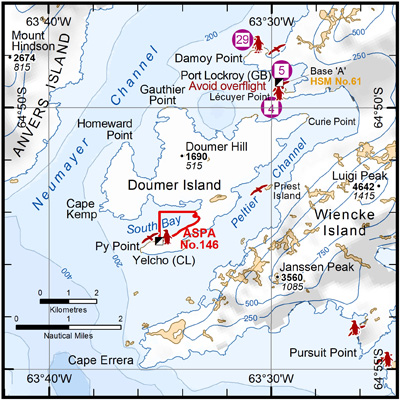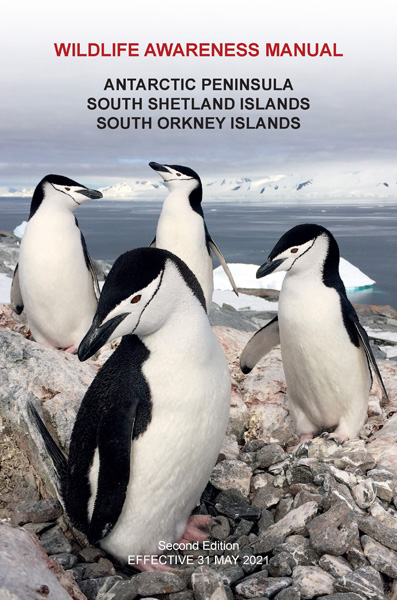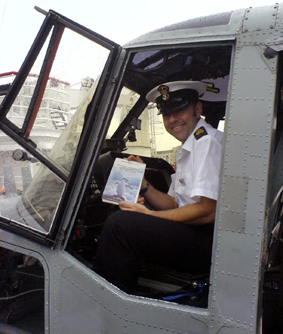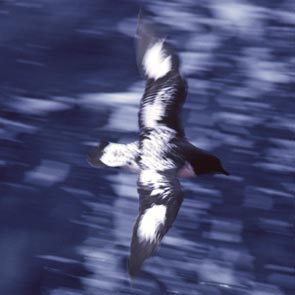Wildlife Awareness Manual (2nd Edition) published May 2021
The Second Edition of the Wildlife Awareness Manual (WAM) field guide covering the Antarctic Peninsula, South Shetland Islands & South Orkney Islands was published on 31 May 2021.
The new edition has comprehensively revised and updated over 160 maps which show the locations of breeding wildlife (penguins, petrels, shags,
fulmars, seals), physical features, scientific stations, and protected sites in the Antarctic Peninsula region. Photographs illustrate local wildlife species and frequently visited sites.
The manual is designed to help pilots avoid wildlife, although the maps, photographs and summary information on wildlife and stations will be of interest
to the more general audience visiting Antarctica. The 156-page WAM is designed in the format of a field notebook (~A5; 140x210 mm), with durable covers and a wiro binding.

Example map of Port Lockroy
The Manual is published on special durable synthetic media designed for field use, which is water- and tear-resistent. This hardcopy field manual is available for purchase (see details below), and can be mailed by air worldwide. A digital version of the WAM is available for download from the link below.
Purchase the Wildlife Awareness Manual (2nd Edition)
The WAM (2nd Edition) is £26.50 plus packing / shipment by Royal Mail (1st class / air) as follows: within UK £7.00; EU £10.00; USA / elsewhere £12.50. ERA does not have an online shop, but we can accept payment as follows:
PayPal ERA no longer accepts payment by PayPal. We now use Stripe for online payments.
Stripe We accept credit card payments by Stripe. Email Colin Harris first with number of copies required, your billing and mailing address. We'll let you know the total cost including postage and Stripe fees. If you wish to proceed, we'll invoice you and payment is made by credit card using Stripe. The invoice will include a secure link to the Stripe online payment facility. You simply click the "Pay Now" button on the email, or you can use the unique link provided on the actual invoice (attached to the email) and that will take you to Stripe. We will be notified when payment is made, and will ship as soon as payment is approved.
Bank Transfer (within the UK) Payment can be made by bank transfer from a UK bank account to ERA's account (within UK by BACS). Prices do not include international wire payment charges which can be expensive, so this is not a great option. Email us first and we can provide more details. Please email Colin should you wish to purchase and prefer not to pay by Stripe.
Digital version of the Wildlife Awareness Manual (2nd Edition)
Download a digital version of the Wildlife Awareness Manual (2nd Edition) (13 MB pdf).
Wildlife Awareness Manual cover: Chinstrap penguins, Useful Island; © Noah Strycker 2019
WAM design & background
The First Edition of the Wildlife Awareness Manual (WAM) was published in 2006. The 2nd Edition has comprehensively improved and updated all the information and maps. The new edition was prepared for the the United Kingdom Foreign, Commonwealth & Development Office, the German Federal Ministry of the Environment and the International Association of Antarctica Tour Operators (IAATO) to help support operations.
Wildlife are potentially sensitive to aircraft noise and visual intrusion (Rounsevell and Binns 1991; Cooper et al. 1994; Giese and Riddle 1999; Harris 2005). The original WAM was developed in collaboration with 212 Flight 815 Royal Naval Air Squadron on HMS Endurance. Helicopters are flexible in where they can land and routinely fly at low elevations, potentially bringing them close to breeding wildlife. The WAM provides information on colony locations so pilots can avoid them.
All known breeding colonies of penguins (Pygoscelis antarcticus (chinstrap), P. adeliae (Adélie), P. papua (gentoo), Eudyptes chrysolophus (macaroni)), Southern giant petrels (Macronectes giganteus), Antarctic petrels (Thalassoica antarctica), Antarctic shags (Leucocarbo [atriceps] bransfieldensis), Southern fulmars (Fulmarus glacialoides), Southern elephant seals (Mirounga leonina)and Antarctic fur seals (Arctocephalus gazella) are included. Skuas (Catharacta sp.), gulls (Larus dominicanus), other petrels, and other seals are not shown because of limitations in data availability.
Wildlife data were compiled in a Geographical Information System by ERA from a wide range of sources (some are listed below), including data contributed by Sally Poncet, Bill Fraser (Palmer LTER), Tom Hart (Penguin Watch), Heather Lynch (MAPPPD) and others. The maps are based on the SCAR Antarctic Digital Database (v.7.2, SCAR 2020). Information on landing sites was provided by HMS Endurance (212 Flight), with more recent information and photos provided by the Chilean Navy (special thanks to Capt. Lars Christiansen Pescio) and the Brazilian Antarctic Programme. Information on protected areas was drawn from the Committee for Environmental Protection (CEP) of the Antarctic Treaty.

"An excellent piece of kit" - POAC Andy Johnson RN, Aircraft Controller, in Lynx cockpit with 1st Edition of WAM on HMS Endurance in Edinburgh 17 June 2006.
Photo: © Susie Grant 2006.
References
212 Flight, 2002-2006. HMS Endurance Helicopter Landing Site Guide. Unpublished 212 Flight internal documents, 815 Royal Naval Air Squadron, Yeovilton.
Cooper, J., Avenant, N.L. & Lafite, P.W. 1994. Airdrops and king penguins: a potential conservation problem at sub-Antarctic Marion Island. Polar Record 30(175): 277-282.
Croxall, J.P. & Kirkwood, E.D. 1979. The distribution of penguins on the Antarctic Peninsula and islands of the Scotia Sea. BAS, Cambridge.
Giese, M. & Riddle, M. 1999. Disturbance of emperor penguin Aptenodytes forsteri chicks by helicopters. Polar Biology 22: 366-371.
Harris, C.M. 2005. Aircraft operations near concentrations of birds in Antarctica: The development of practical guidelines. Biological Conservation 125: 309-22.
Humphries, G., Naveen, R., Schwaller, M., Che-Castaldo, C., McDowall, P., Schrimpf, M. & Lynch, H. 2017. Mapping Application for Penguin Populations and Projected Dynamics (MAPPPD): Data and tools for dynamic management and decision support. Polar Record 53(2): 160-66.
Lynch, H.J. 2021. Mapping Application for Penguin Populations and Projected Dynamics (MAPPPD). Online database accessed Jan/Feb 2021 at http://www.penguinmap.com/mapppd.
Naveen, R. & Lynch, H.J. 2011. Antarctic Peninsula Compendium, 3rd Edn. Report to the US Environmental Protection Agency. Oceanites, Chevy Chase, Maryland.
Rounsevell, D. & Binns, D. 1991. Mass deaths of King Penguins (Aptenodytes patagonicus) at Lusitania Bay, Macquarie Island. Aurora 10(4): 8-10.
SCAR Antarctic Digital Database (ADD) Version 7.2 2020. Maintained by British Antarctic Survey, Cambridge.
Schrimpf, M.B., Che-Castaldo, C. & Lynch, H.J. 2020. Regional breeding bird assessment of the Antarctic Peninsula. Polar Biology 43: 111–22.
Schrimpf, M.B., Naveen, R. & Lynch, H.J. 2018. Population status of the Antarctic shag Phalacrocorax (atriceps) bransfieldensis. Antarctic Science 30 (3): 151–59.
Strycker, N., Borowicz, A., Wethington, M., Forrest, S., Shah, V., Liu, Y., Singh, H., & Lynch, H.J. 2021. Fifty-year change in penguin abundance on Elephant Island, South Shetland Islands, Antarctica: results of the 2019–20 census. Polar Biology 44: 45–56.
Strycker, N., Wethington, M., Borowicz, A., Forrest, S., Witharana, C., Hart, T. & Lynch, H.J. 2020. A global population assessment of the Chinstrap penguin (Pygoscelis antarctica). Nature Scientific Reports 10:19474.
Woehler, E.J. 1993. The distribution and abundance of Antarctic and Subantarctic penguins. SCAR, Cambridge. [Updated 2004].


